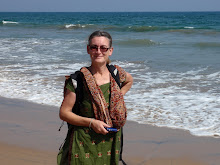We hired a taxi today to take us to the village of Kotpad, near the border with the neighbouring state of Chattisgarh. Kotpad is famous for it's traditional fabric dying and weaving, using pure cotton or silk, natural vegetable dyes and handlooms, weaving traditional patterns into the fabrics. The taxi driver did not speak English but with the help of my friend Dusmant over the telephone we managed to convey what we wanted to see in the village. With the assistance of a few pedestrians in the town and one who jumped into our car to give directions we managed to find what we were looking for down a tiny little back street where we were made very welcome by the family running that particular weaving and dying enterprise.
The cotton is brought in from Chattisgarh in its raw state. Castor oil and cow dung paste are massaged into the hanks of yarn and then dried in the sun for 12 days to get an even, light, natural colour.
The yarn is then massaged by the dyers stamping on them. The fibre is left incredibly soft by all the soaking and massaging. The yarn that this woman is holding here felt really soft, similar to cotton wool
The weavers grow aal and harvest the roots. Bits of the root are chipped off and collected for drying. The brittle red root-bark gives the color and is chipped off and ground to a fine powder in a stone mill like the ones used for spice or flour. This is then mixed with hot water and used to dye the yarn, being left to soak for around 12 hours with a bit of pummelling to help the dye to impregnate the yarn. The colour of the aal dye can be varied by adding iron dust to give a browner colour and a variety of other dyes are used to get other variations. Unfortunately my lack of Oriya limited my understanding of the explanations that the family were really keen to give.
The yarn is hung to dry then wound into hanks ready for the weaving process.
Kotpad weavers do everything on a simple loom. Everything is done by hand with small shuttles of yarn. The patterns are created by looping yarn in the weft and into the warp. The loom is very rudimentary with thread heddles tied to foot pedals. It apparently takes 20 days to weave a sari length! These saris and shawls are generally done in two colors, one ground and one ornament color, traditionally red on white grounds. All ornament is made with the secondary color. They weave in pure cotton, silk and silk/cotton mix. When you feel this fabric it is incredibly soft.
The finished fabrics were gorgeous and of course I fell for far more than I could really afford but when I compared the prices being charged with those being charged for machine woven fabrics available in the UK they were a bargain. I hope will brighten the day for a few people at home but I did treat myself to a sari length which I will need to take to my friendly deaf tailor to get the choli made up.












No comments:
Post a Comment